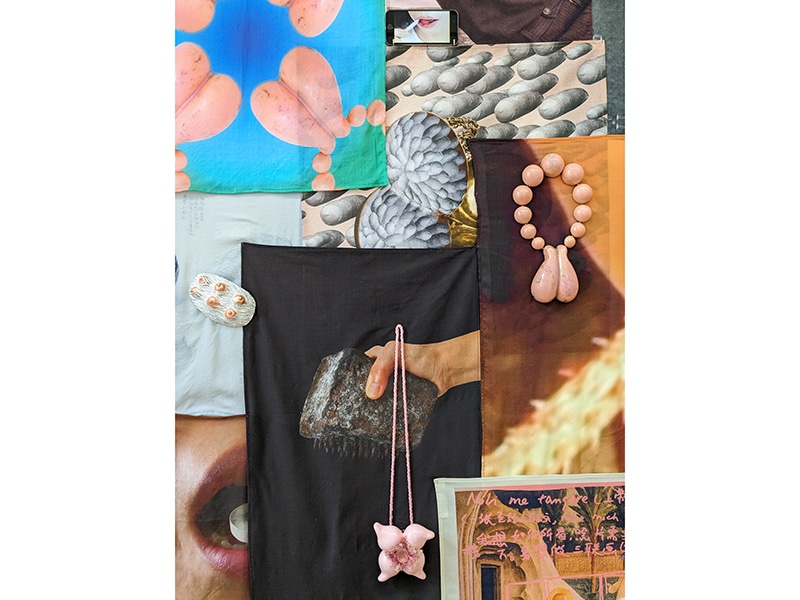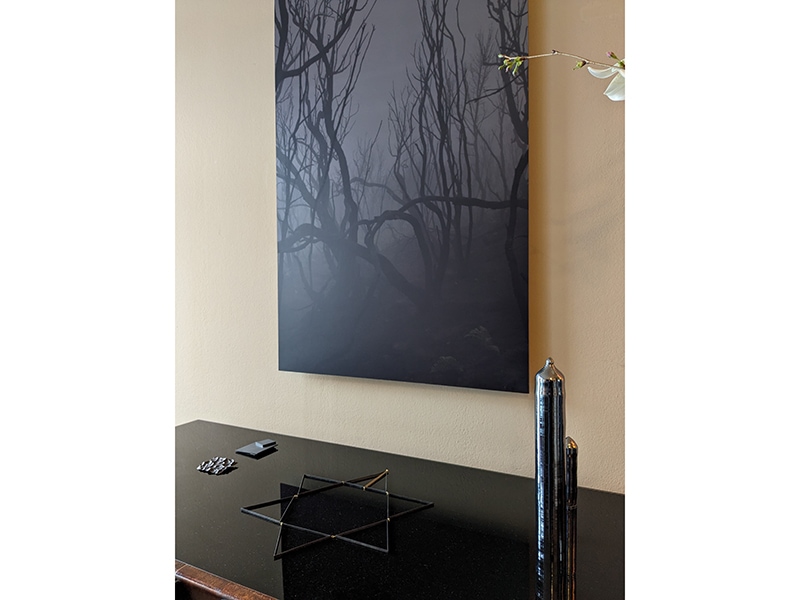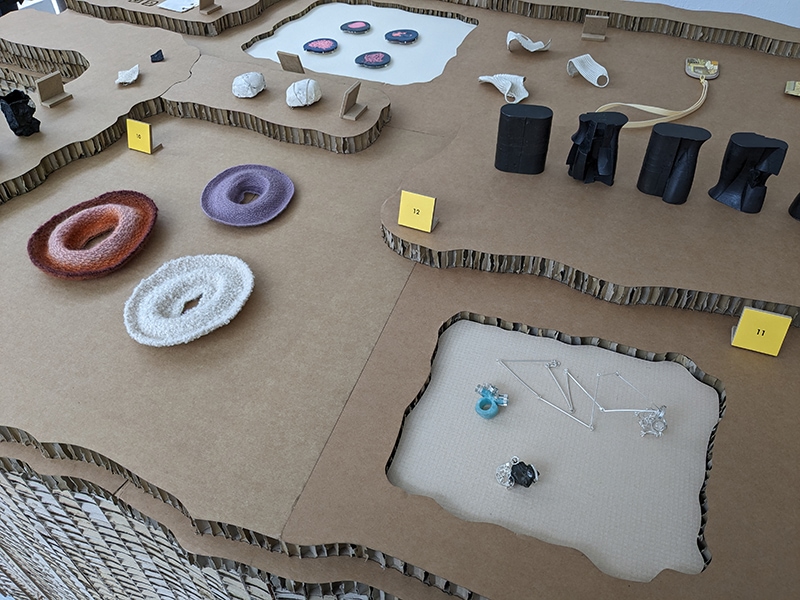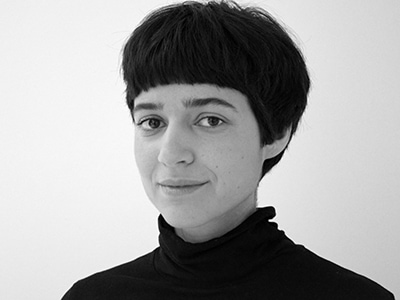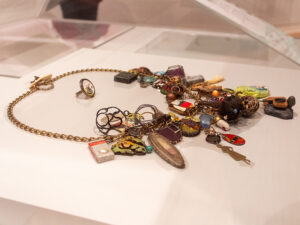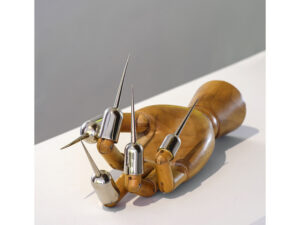Munich Jewellery Week (MJW) is like fungi, with exhibitions popping up throughout the city.
For many of those holding these shows, MJW means organizing an exhibition abroad in a space they’ve only seen online, with limited setup time. Creating a scenography entails not only selecting materials that are easily transportable or locally available, but also striving to stand out among many events, all while ensuring the presentation supports the work.
Faced with numerous challenges, and opportunities, exhibitors experiment with presentation strategies. MJW is a playground.
This text discusses a selection of MJW24 exhibitions. This is not a complete overview, nor a best-of. Instead, if offers insights into different presentation methods. Ideally, I could have explored more exhibitions, but that, too, is typical of MJW: navigating a vast array of choices.
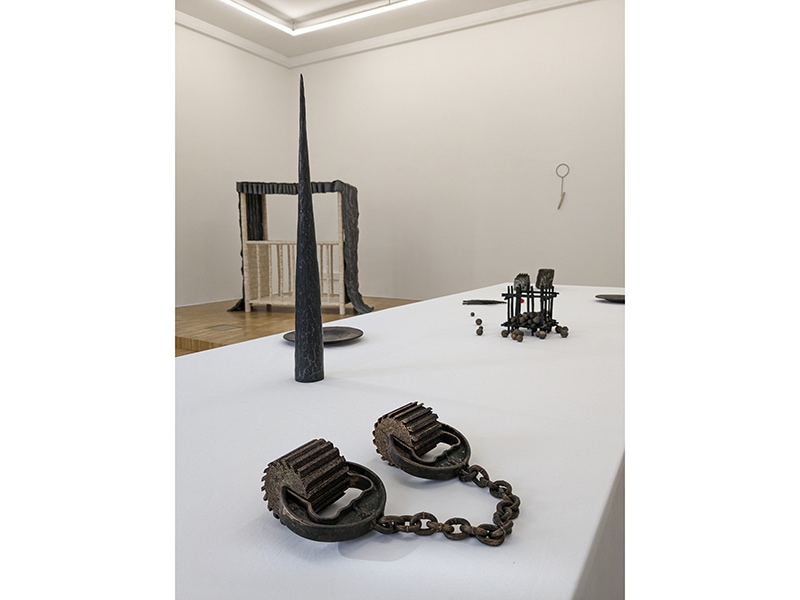
Drops of the Juice, at The Tiger Room, February 28–March 23, 2024
This exhibition showed Danni Chen’s works from past years.

As I enter the exhibition, I scan its arrangement: a sculpture resembling a baby bed created from rice crackers and lead, a choker encasing an asparagus suspended against the wall, a tablet playing a video while serving as a platform for metal tongue pieces. On the left, a colorful wall composition catches my eye. It features a multitude of textiles, jewelry, and smartphones. One screen depicts a mouth picking raspberries from metal pins.
Chen describes this installation as a spatial catalog of her artistic works. One print shows a hand holding a spiked object, ready to crush a bunch of grapes. This piece is part of Chen’s “fruit tortures,” displayed on a table across the gallery. The artist points out other pieces: “These balls can stone fruit, while that roller crushes raspberries.”

Contrasting the table’s pristine white cloth and black chairs, Chen’s pieces shimmer in the gallery’s fluorescent lights. Occasionally, a mysterious sound emerges from beneath, perforating the white cube’s membrane.
C and the Artist, at Versus Gallery, February 27–March 3, 2024
Since my first visit to an exhibition curated by Christian Hoedl in an antique shop years ago, attending his MJW presentations has become a tradition for me. What interests me is his strategy of placing contemporary jewelry within distinctive interiors.
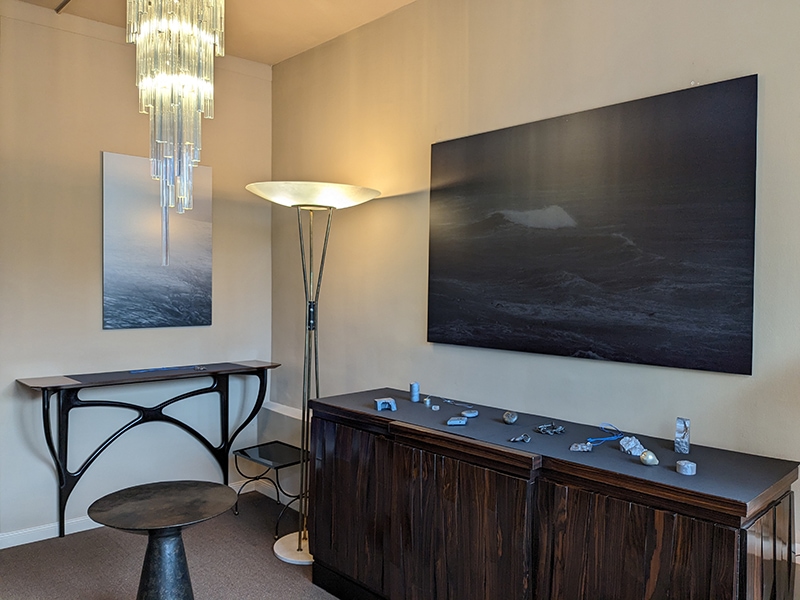
For this latest iteration, six artists’ works were presented: Marcus Biesecke, Marlène Burguet, Patrícia Domingues, Sophie Hanagarth, Philip Sajet, and Tim Udvardi-Lakos.
Hoedl collaborated closely with Florian Specht, the gallery owner, to select and arrange the gallery’s furniture to present the jewelry and the objects. Additionally, Hoedl invited Karen Irmer to exhibit her photography, which, as Specht notes, “seems to transform throughout the day, responding to the play of light like a film.” A fascinating interplay indeed occurs, with the designer lamps casting a soft glow on the jewelry, the wooden cabinets, their flowing nerves.
Hoedl’s approach encourages reflection on the connection between jewelry and its context, leaving me to ponder how a setting influences the viewer’s perception and engagement with the work.
Mystic Cubicles: Crafted Whispers, at AkademieGalerie, February 21–March 3, 2024
Located in a subway station, a glass box amid the perpetual motion of escalators, ads, and commuters, AkademieGalerie offers a fascinating setting for art. Standing still in this turmoil, I peer through the gallery’s windows at the exhibition showing works by students from Klasse Prof. Karen Pontoppidan für Schmuck und Gerät, Akademie der Bildenden Künste München, with work by Chung-Yueh Yuan, Martha Schmidt, Sylvia Berté, Isu Choi, Regina Rupp, Nora Reitelshöfer, Suvi Tupola, Maria Eugenia Muñoz, Yegyu Shin, Jonas Möller, Florian Clemens Meier, Anna Avits, and Julius Fest.
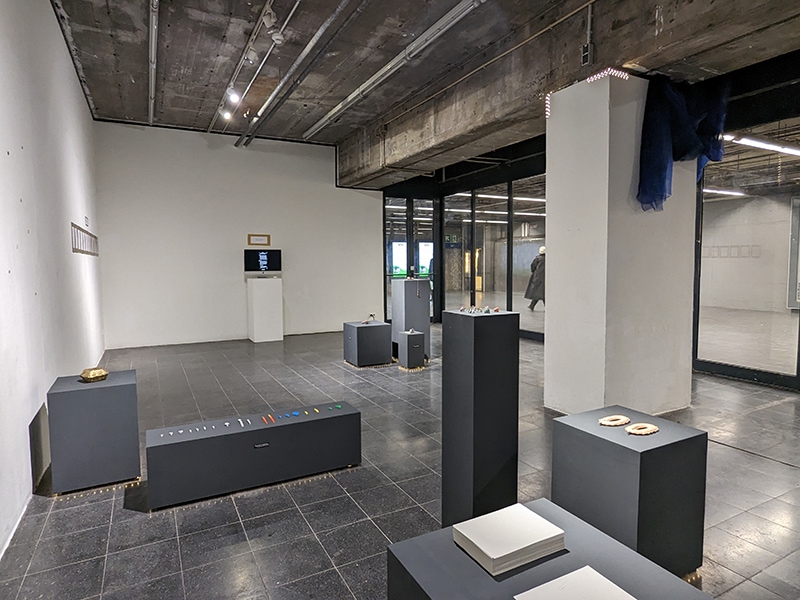
Anthracite-colored pedestals seem to hover above the ground, casting LED reflections on the floor. The entrance is adorned with blue drapes and light garlands, the exhibition’s title whimsically written and framed in gold. These choices are … interesting, I find myself thinking, wondering about the need for elaborate decorations and their connection to the floating plinths.
Moving among the pedestals, I observe the works. At the back of the space, “Voices of the Artisans” includes a series of artists’ statements. As I read, my focus shifts between the texts, the works, the plinths … and a computer displaying a video.

And suddenly it clicks. The screen reveals a conversation with ChatGPT. Extensive lists of ideas and options for curating the exhibition scroll by.
I am curious to what extent the exhibitors followed ChatGPT’s instructions. Did the team step in to ensure the presentation supports the works, rather than overshadow it with a random extravaganza? Reflecting on the potential impact of fully embracing AI’s guidance on the work’s presentation and perception, I wonder whether this fascinating experiment could have been taken to more extreme lengths.
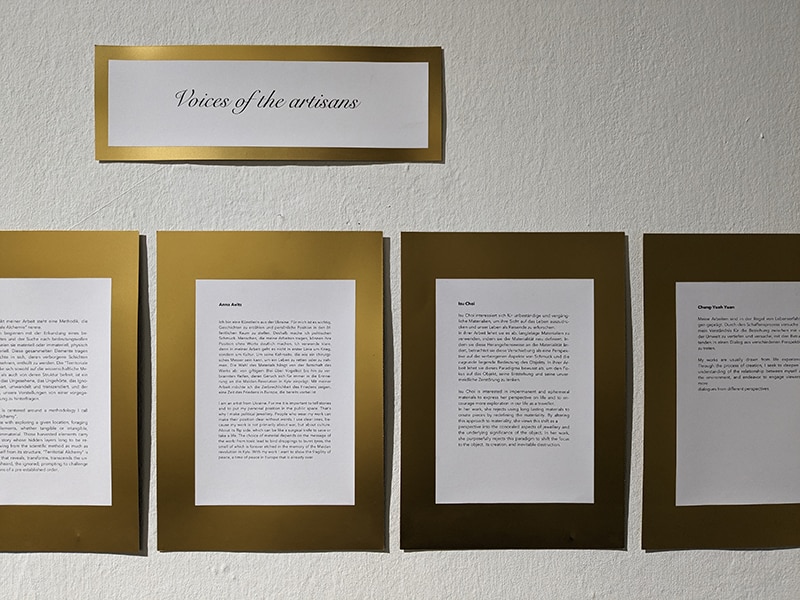
Artist Jonas Möller sheds light on the exhibition’s process. The team fed ChatGPT information about concepts and materials to initiate dialogue. The exhibition’s title, concept, and design emerged from the conversation that provided the most comprehensive information about their work and the contemporary jewelry field. Because they wanted the presentation to prioritize their artistic positions, the artists decided to intervene if the AI’s suggestions contradicted their rules, put their work in a negative light, or exceeded their resources regarding time, budget, and space.[1]
For the exhibitors, co-curating with AI revealed ChatGPT’s narrow understanding of jewelry as a medium for fine art, a limitation they see echoed in the general public’s perception of jewelry. “Even after explaining our work, the AI still suggested portraying us as skilled professionals creating valuable pieces using precious materials.”[2]
Importable/M.A.Y.A (Unwearable/M.A.Y.A), at Institut Français, February 26–March 3, 2024
Intrigued by its title and photos, this was one of the exhibitions I was most curious to explore. It features work by Marie-caroline Locquet.
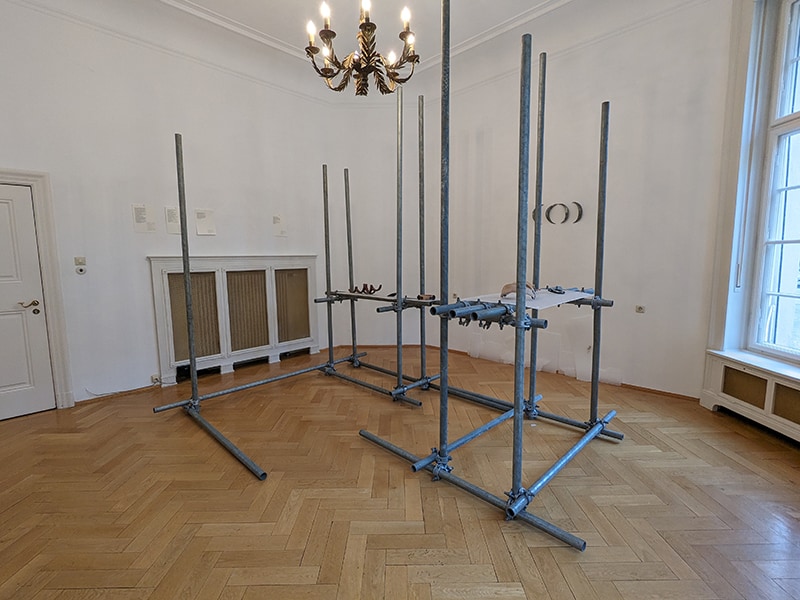
Scaffolding constructions support translucent wax sheets, on which Locquet’s jewelry is displayed. Along the walls, paraffin sheets with brooches showcased at the center hang from chains embedded in the material, reaching down to the ground. Chokers are presented with their wooden pins extending upward, yet seamlessly closing into a circle around the neck.

A selection of texts by Victor Dumiot, a French writer whom Locquet invited to collaborate with after she read one of his novels, is shown alongside the jewelry that inspired them. Loquet, in turn, drew inspiration from Dumiot’s writing to produce a new piece, which is presented adjacent to the literary work.

The robust iron tubes and malleable wax set against a backdrop of baroque surroundings, complete with chandeliers and ornamental wallpaper, evoke an intriguing tension. The monumental and the bantam. Strength and delicacy.
Treasure Peninsula, at super+Centercourt, February 26–March 4, 2024
This show features graduate students from the Department of Crafts at Seoul National University, South Korea: Hyemin Jang, Pilho Kang, Hyemin Ahn, Yeonmi Lee, Yoojung Kim, Yebin Kim, Haesun Shin, Shang Gao, Jixuan Lu, Yujin Ok, Ziyune Kim, Soohyun Chou, Dongryeol Yoo, Heesun Kim, Jieun Yoo, Heesu Kim, Dahee Park, Kyuman Hong, Miseo Choi, and Hyeokjae Lee.
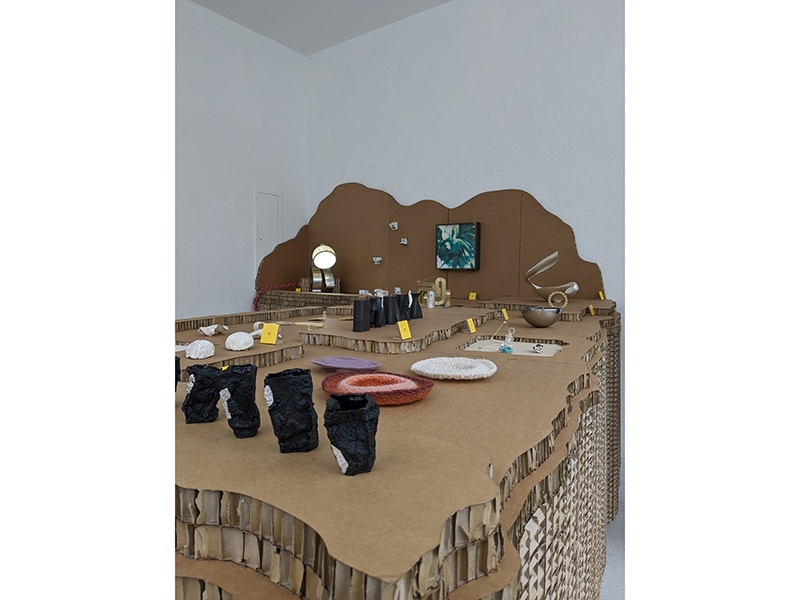
A large honeycomb cardboard volume occupies most of the space, serving as a platform for presenting jewelry and objects.
Inspired by a peninsula, excavations, and digging, the display metaphorically represents uncovering and revealing the students’ talents. It takes on a landscape-like quality, with some sections raised and others lowered. The archaeological theme is reinforced by the exhibition’s leaflet and numbered tags accompanying the displayed works. These tags correspond to a grid of business cards placed on a pedestal at the entrance.

The cardboard—sustainable, light, strong—extends onto the windowsill, showcasing series of jewelry. In the corner, two stools crafted from the same material complete the setup.
Wunderkammer, at the Orangerie, February 28–March 3, 2024
This group exhibition, curated by Tobias Birgersson and Prof. Heiner Zimmermann, shows works by 24 artists: Tobias Birgersson, Heiner Zimmermann, Karl Hallberg, Lina Söderberg, Marcello Ferreira, Emille deBlanche, Jokum Lind Jensen, Karolina Hägg, David Clark, Jorge Manilla, Adam Hawk, Rick Smith, John Grayson, Andrew Hayes, Seth Gould, Sabine Straub, Klara Birgersson, Urmas Lüüs, Nils Hint, Piret Hirv, Eve Margus-Villems, Johannes Postlmayr, Janne Peltokangas, and Daniel Strandow.

I am curious what referencing the historical format of the Wunderkammer[3] could mean for a contemporary craft exposition.
A large shelving unit presents a range of contemporary craft pieces and curious found objects alongside items such as cardboard boxes and gloves. Visitors are encouraged to actively search for the artworks amidst the multitude of objects and materials. Both handmade and found objects are labeled with archival tags featuring fictional and often humorous descriptions, with a small corresponding number revealing the creator’s name.
Curator Prof. Zimmermann explains that the exhibition represents the study program Metal Art at Campus Steneby, Gothenburg University, Sweden. It includes works from teachers, alumni, and external professionals. The artists were invited to show one of their works fitting the Wunderkammer theme, along with a found object sparking imagination about its purpose.

To address the challenge of exhibiting a diverse range of work, the curators opted for the Wunderkammer format. “Known for its diversity and curiosity, a Wunderkammer invites the audience to investigate the displayed pieces.”[4]
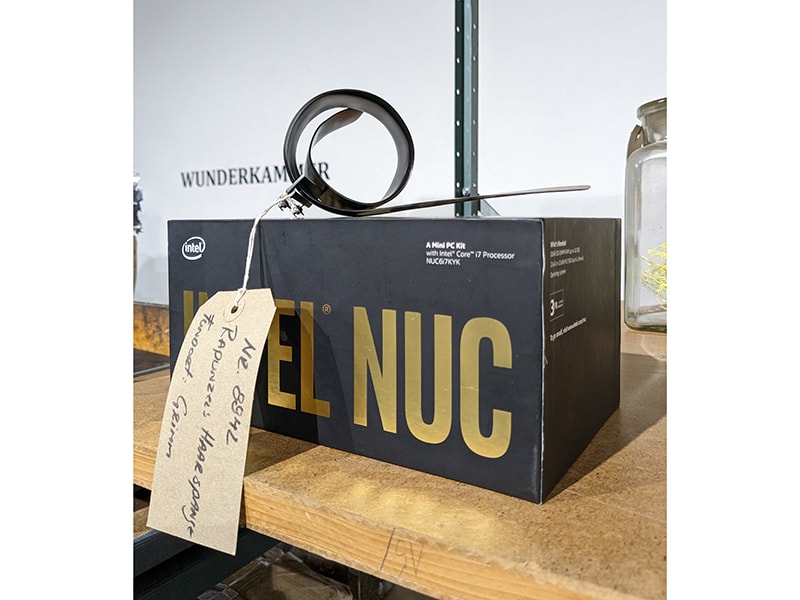
Rather than filling a small room with objects, as is the case in the historical cabinets of curiosities, the dimensions of the Orangerie inspired them to create “a modern Wunderkammer in the form of an archive or storage, akin to those found in a museum or storage space.”[5]
By curating an experience that brings a diversity of objects into relation, the organizers aim to share not only the results of crafts but also ignite curiosity about its processes and methods. Understanding the intricacies of how and why something is made can enhance the appreciation of the works, as Prof. Zimmermann argues. Making exhibitions is their attempt in asserting the relevance of crafts, both past, present, and future, Birgersson concludes.[6]
As suddenly as MJW exhibitions appear, most of them end just as quickly. Yet, the global network they emerge from continues growing. Similar to fungi dispersing spores, these exhibitions leave behind traces—seeds that take root elsewhere.
My suitcase brimming with flyers and postcards of all the exhibitions I visited, or hoped to attend, and my heart filled with excitement, I return home, marking the dates for next year’s anticipated fairy ring.
We welcome your comments on our publishing, and will publish letters that engage with our articles in a thoughtful and polite manner. Please submit letters to the editor electronically; do so here.
© 2024 Art Jewelry Forum. All rights reserved. Content may not be reproduced in whole or in part without permission. For reprint permission, contact info (at) artjewelryforum (dot) org
[1] From an email conversation with Jonas Möller, March 11 and 12, 2024.
[2] Ibid.
[3] As I reflected on the contemporary significance of the Wunderkammer while writing this essay, I became aware of the potential undertones of colonial narratives that may be reinforced by this format. While acknowledging the importance of such a debate, delving into it further exceeds the scope of this essay.
[4] From an email conversation with Prof. Heiner Zimmermann and Tobias Birgersson on March 11, 2024.
[5] Ibid.
[6] Ibid.

